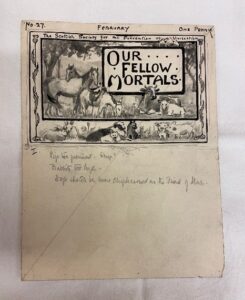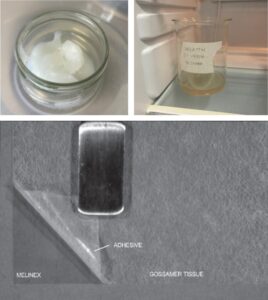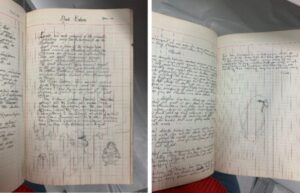By Amanda Dodd, Projects Conservator, Heritage Collections
In this week’s blog, Amanda Dodd reviews the work she did on the One Health Project with a particular focus on this use of more sustainable materials when conserving collections.

Above: Rehoused R(D)SVS photograph and ornate frame of O.C. Bradley.
In October 2023 I took over as Project conservator for The One Health initiative. A little bit of background: The project, generously funded by the Wellcome Trust, was a monumental effort to catalogue, preserve, and provide access to three distinct archival collections pertaining to the evolution of animal health and welfare in Scotland from the 1840s onwards. These collections include the Royal (Dick) School of Veterinary Studies (R(D)SVS), OneKind Animal Charity, and the Royal Zoological Society of Scotland (RZSS).
Each collection holds a plethora of historical objects, from bound volumes and loose-leaf materials to an extensive array of photographs and glass plate negatives all documenting the evolution of veterinary science, animal welfare activism, and wildlife conservation efforts. However, amidst the meticulous conservation work, a new ethical consideration emerged – posing that almighty question … Is that Vegan?
One Kind, now housed within Heritage Collections, who among many pillars implore people to “Live Compassionately” underpins the idea of advocating for animals and inspires people to connect and enhance their lives. Which made us feel particularly empowered to also align with this ideology in the way we carry out conservation treatment.

‘Artwork for the Scottish Society for the Prevention of Vivisection’s magazine, ‘Our Fellow Mortals’, c.1915, from the OneKind Archive, Coll-1618/1/4/2/2.
Traditionally, conservation materials such as adhesives, cleaning agents, protective coatings and even our tools may, to some degree, contain animal-derived ingredients or, are indeed made from them. This would raise concerns for anyone adhering to a lifestyle and philosophy that seeks to avoid the exploitation and cruelty of animals in all aspects of life, including their professional endeavours. Luckily, within a lot of what we do and particularly within the Paper conservation discipline, we tend to use products for our treatment that are plant-based and animal free.
An example of this would be, Wheatstarch as our adhesive and/or poultices, Cellulose derivatives for any specialist crease removal and a lot of remoisten-able tissue for delicate and speedy repairs! (A very light weight tissue that is impregnated with a thin layer of your chosen adhesive, dried on a plastic polyester/Melinex sheet and then wetted out lightly when needed.)

Top left: Wheatstarch adhesive. Top right: 3% Gelatine adhesive. Bottom: A close-up of a piece of remoisten-able tissue on supported on melinex, and a metal spatula tool.
We embarked on a journey to reassess and, where possible, use materials that were already vegan and used within the profession or replace with vegan alternatives. This shift not only aligned with the ethos of the project but, also reflected a broader commitment to ethical and sustainable practices within the field of conservation. For example, waste disposal changes, recycling and moving to working with other institutions when bulk ordering.
In light of this, this made us even more conscious of what we were doing and worked closely with the team at OneKind who were really receptive to our proposals and any changes that we wanted to implement. With the aim to always engage in a constructive dialogue about the use of animal products, discussing when and why they may be necessary in conservation practices and exploring alternative methods when possible. For example, I still believe one of the primary challenges we are faced with is finding vegan-friendly alternatives to the likes of animal-based adhesives and animal hides and parchments used instead of paper, as our treatment proposals are heavily led by the original materiality of the object, its makeup and ethics.
As the project progressed, we witnessed first-hand the positive impact of incorporating vegan principles into conservation practices. Not only did it enable us to uphold our ethical values, but it also sparked meaningful conversations within the conservation community about the intersection of animal rights and cultural heritage preservation.

Above left to right: “Names, Habitats, etc; of animals, birds, reptiles and fish, in the Zoological Park Edinburgh”, 1971, from the RZSS Archive, Coll-2099
In conclusion, working on this project has provided me with a unique opportunity to explore a diverse range of objects, archival documents, and photographic materials, all united by a common goal – the advocacy for and enhancement of animal welfare. This experience has been invaluable in reshaping my perspective on ‘conscious conservation’ practices, particularly in relation to Veganism and the broader environment.
The significance of this shift was magnified by the close collaboration with the project archivist and postdoctoral researcher. Their expertise and insights not only enriched the conservation process but, also deepened my understanding of the intersection between ethical principles and conservation methodologies.
